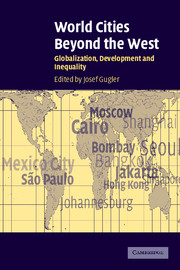Book contents
- Frontmatter
- Contents
- List of figures
- List of maps
- List of tables
- List of contributors
- Acknowledgments
- World cities beyond the West
- Introduction
- Part 1 The impact of the global political economy
- Part 2 The impact of the state
- 6 Moscow's changing fortunes under three regimes
- 7 Hong Kong's pathway to becoming a global city
- 8 Singapore: forming the family for a world city
- 9 Jakarta: globalization, economic crisis, and social change
- Part 3 The impact of popular movements
- Afterword
- Index
- References
9 - Jakarta: globalization, economic crisis, and social change
Published online by Cambridge University Press: 12 October 2009
- Frontmatter
- Contents
- List of figures
- List of maps
- List of tables
- List of contributors
- Acknowledgments
- World cities beyond the West
- Introduction
- Part 1 The impact of the global political economy
- Part 2 The impact of the state
- 6 Moscow's changing fortunes under three regimes
- 7 Hong Kong's pathway to becoming a global city
- 8 Singapore: forming the family for a world city
- 9 Jakarta: globalization, economic crisis, and social change
- Part 3 The impact of popular movements
- Afterword
- Index
- References
Summary
Jakarta is a mega-city which stands astride the economic, political, and (arguably) cultural landscape of Indonesia. As a center of finance and administration it is Indonesia's gateway to the global economy. However, its rapid and chaotic growth has created an urban fabric of complexity and contrast which has been impossible to service or manage in a comprehensive or effective way. Yet the city remains a key symbol in Indonesia, is regarded with genuine affection by many of its inhabitants, and is still a magnet for migrants from across the archipelago. It is sometimes represented as a city of villages that retain much of their rurality. Like a number of other cities, Jakarta embodies, in an exaggerated way, many of the core contradictions of modernity. Since 1997 Indonesia, and with it Jakarta, has experienced economic and political crisis and profound change. Few are able confidently to predict the outcome, but it has seriously slowed Jakarta's progression towards steadily acquiring a greater array of world city functions.
This chapter consists of three parts. In the first I make transparent the theoretical architecture which has guided construction of the chapter, then briefly outline Jakarta's history, establishing the foundations of its contemporary characteristics. The second part examines salient characteristics of Jakarta under the New Order (Order Baru) from 1965 until 1998, when the current infrastructure and modernist identity of the city was fashioned in its engagement with the global economy.
- Type
- Chapter
- Information
- World Cities beyond the WestGlobalization, Development and Inequality, pp. 268 - 296Publisher: Cambridge University PressPrint publication year: 2004
References
- 1
- Cited by



